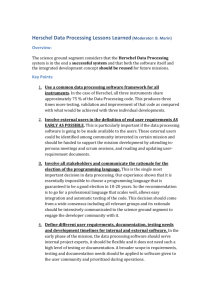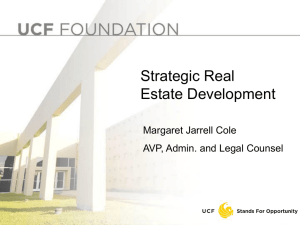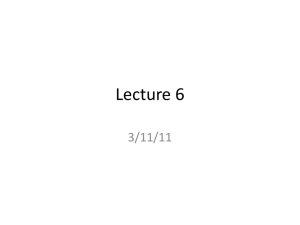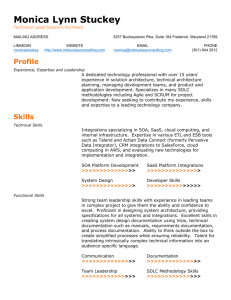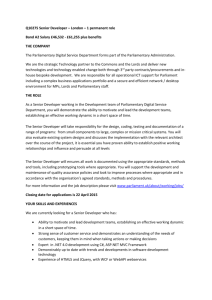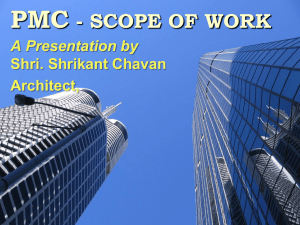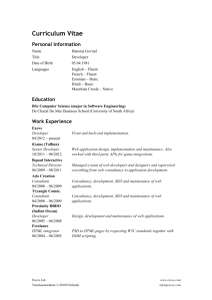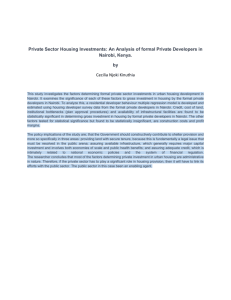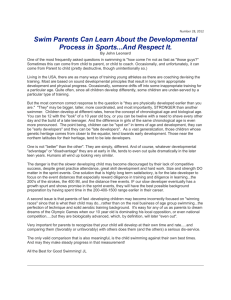developer´s strategic use of urban design in norwegian
advertisement
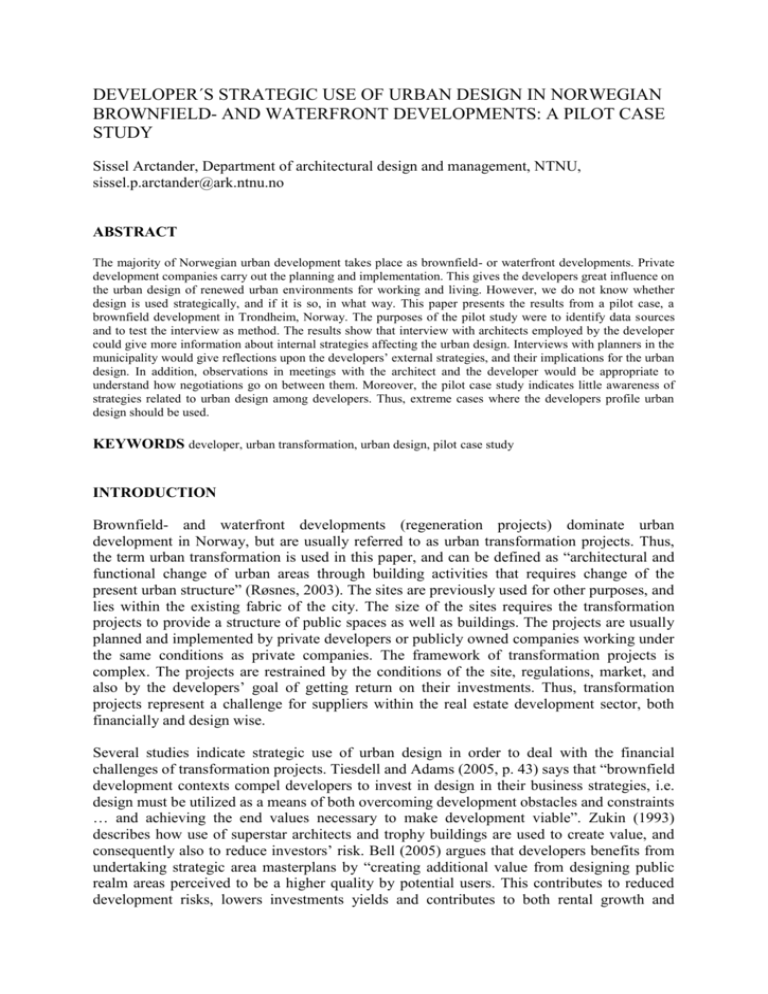
DEVELOPER´S STRATEGIC USE OF URBAN DESIGN IN NORWEGIAN BROWNFIELD- AND WATERFRONT DEVELOPMENTS: A PILOT CASE STUDY Sissel Arctander, Department of architectural design and management, NTNU, sissel.p.arctander@ark.ntnu.no ABSTRACT The majority of Norwegian urban development takes place as brownfield- or waterfront developments. Private development companies carry out the planning and implementation. This gives the developers great influence on the urban design of renewed urban environments for working and living. However, we do not know whether design is used strategically, and if it is so, in what way. This paper presents the results from a pilot case, a brownfield development in Trondheim, Norway. The purposes of the pilot study were to identify data sources and to test the interview as method. The results show that interview with architects employed by the developer could give more information about internal strategies affecting the urban design. Interviews with planners in the municipality would give reflections upon the developers’ external strategies, and their implications for the urban design. In addition, observations in meetings with the architect and the developer would be appropriate to understand how negotiations go on between them. Moreover, the pilot case study indicates little awareness of strategies related to urban design among developers. Thus, extreme cases where the developers profile urban design should be used. KEYWORDS developer, urban transformation, urban design, pilot case study INTRODUCTION Brownfield- and waterfront developments (regeneration projects) dominate urban development in Norway, but are usually referred to as urban transformation projects. Thus, the term urban transformation is used in this paper, and can be defined as “architectural and functional change of urban areas through building activities that requires change of the present urban structure” (Røsnes, 2003). The sites are previously used for other purposes, and lies within the existing fabric of the city. The size of the sites requires the transformation projects to provide a structure of public spaces as well as buildings. The projects are usually planned and implemented by private developers or publicly owned companies working under the same conditions as private companies. The framework of transformation projects is complex. The projects are restrained by the conditions of the site, regulations, market, and also by the developers’ goal of getting return on their investments. Thus, transformation projects represent a challenge for suppliers within the real estate development sector, both financially and design wise. Several studies indicate strategic use of urban design in order to deal with the financial challenges of transformation projects. Tiesdell and Adams (2005, p. 43) says that “brownfield development contexts compel developers to invest in design in their business strategies, i.e. design must be utilized as a means of both overcoming development obstacles and constraints … and achieving the end values necessary to make development viable”. Zukin (1993) describes how use of superstar architects and trophy buildings are used to create value, and consequently also to reduce investors’ risk. Bell (2005) argues that developers benefits from undertaking strategic area masterplans by “creating additional value from designing public realm areas perceived to be a higher quality by potential users. This contributes to reduced development risks, lowers investments yields and contributes to both rental growth and capital growth” (ibid: p.107). However, these studies do not show how the interests of developers and investors are related to urban design issues, within the development processes. If urban design is used strategically, in what way do developers use it? And what are the implications for the build environment? The question in this paper is how to study the developers’ strategic use of urban design in Norwegian transformation projects. The paper presents a pilot case study related to research strategies and methods. The first part is a discussion of research strategies and what data sources to use. The second part presents a pilot case study, included methods and results. The last part presents implications for further studies. RESEARCH STRATEGY Although the build environment is a part of the study, it is the developer within a process where different stakeholders interact and come to decisions, which is to be investigated. Thus, research strategies from social sciences are applicable. Yin (2003) distinguishes four strategies: experiment, history, survey and case study. According to Yin, case studies are appropriate when: “a “how” or “why” question is being asked about a contemporary set of events, over which the investigator has little or no control”. Surveys do not work when operational links are to be discovered, while experiments are impossible in real-life contexts, where input and output cannot be controlled. Historical studies use documents and artefacts as sources, while this kind of study would exclude information from the stakeholders involved. It would not allow investigation of the intentions of the actions and decisions that took place. The advantage of case studies is their ability to deal with phenomena that have “more variables of interest than data points” (Yin, 2003, p.13). Also, case studies allow the use of both qualitative and quantitative data. Moreover, case studies are “important for the development of a nuanced view of reality, including the view that human behaviour cannot be meaningfully understood as simply ruled-governed acts found at the lowest levels of the learning process” (Flyvbjerg, 2004, p. 422). Closeness to the object of study is also necessary for the researcher to learn the subject, and thus avoid superficial research results (ibid.). The purpose is to understand one particular stakeholder in a process and this stakeholders’ influence on the outcome. To answer this question, we need to understand the developers role in the process, the developers interests and the outcome / the urban design. Since there are a number of factors that could influence the developer role, the developer’s interests and the urban design, we need to have knowledge about the process of the transformation project, and about the context of the transformation project. Thus, case studies are appropriate as research strategy. It is viable for investigating the strategic use of urban design within the real estate development process, because “the case study method allows investigators to retain the holistic and meaningful characteristics of real-life events” (Yin, 2003, p. 2). The case studies need to cover the context of the urban transformation projects. However, the focus of the case studies is the developers’ attitudes, intentions and actions. And in addition, the case studies have to cover the outcome of the process, in terms of urban design. The scope should be narrowed to the phases where the urban design is established. This is in the development plan or the detailed development plan, according to the Norwegian Planning and Building Act. Data sources and methods The data sources that would give information about the developers interests and actions are the developers themselves, and the stakeholders working close to the developers in urban design issues. In addition the following documents are relevant; resumes from meetings, plan sketches, the approved plan, and public records from the process. In cases where there has been an architectural competition, the documents from the competition will have valuable information. Literature on Norwegian transformation projects describes close cooperation between municipality and developers. The two parts negotiate about implementation and financing during the whole process (Plathe, 2004, Jensen, 2004). Developers engage architects to prepare the plans, and the Planning and Building Act requires user involvement during the process. However, this is too little information for developing an instruction for the data collection. More information is needed about who participates and what discussions take place between the participants. Regarding urban design, it is also necessary to find out whether the development plan and the development plans are the right levels to investigate. Methods for data collection are mainly interviews and document retrieval and analysis. The developer is the key informant, and the information we are seeking, is qualitative. Interview as method allow investigation of a persons actions and the rationale for their actions. In order to ensure the best possible results from the interviews, the interview guide should be tested. To conclude, case studies are a viable research strategy for investigating the developer’s strategic use of urban design. However, more information is needed on how the process is undertaken, in order to identify data sources. Also, the interview as a means to get information from the developer should be tested. A pilot case study provides more knowledge on who participates in the process, and allows testing of the interview guide. PILOT STUDY Pilot studies are used to test methods, not to answer the research question itself. The pilot case was Marienborg in Trondheim, a transformation project with a context similar to the framework described in the previous part. The development company is ROM Eiendom. It is a national company, where project executives from the whole country meet regularly to discuss and learn from each other. The case was a typical case. A large, central site is to be transformed from industry to a mixed-use area for education and housing. Another reason for choosing the case was that the development plan was recently approved, so the informants would be able to recall details from the process. The case study consisted of an interview with the developer and of a study of the development plan; map, by-laws and illustration plan. The interview guide was designed to learn about the planning process, particularly who participated and what was discussed. In addition, the interview guide covered issues related to urban design. The purpose was to test how the developer can provide information that helps answer the research question. The interview was semi structured, covering the company, the case and the process. Design issues were covered by more specific questions (see Table 1). Table 1. The interview guide __________________________________________________________________________________ Company Transformation project Process Design issues Purpose? Year? Size? Use? Organisation of the planning process? Cooperation with the municipality? Who participated in the process? What was discussed in meetings? What influence has the developer? Reason for choice of architect? Developers’ interest in the urban design of the project? Branding? ___________________________________________________________________________ The project executive was asked if I could interview him about the planning process of their project, and about some of my findings from literature. The interview took place in the office of the company. The project executive had prepared to show a power point presentation of the company and the planning process of this particular site. A projector placed on the table, showed the presentation on the wall. Another project manager took part the last half of the interview. The interview was in Norwegian. I made notes during the interview, and wrote the resume in English. The interview lasted for 1, 5 hours, and our conversation afterwards lasted for about 15 minutes. After the interview I got the illustration plan, the development plan map, and the by-laws of the approved plan. Another meeting with the project executive was held in order to verify my conclusions from the interview. Figure 1. Illustration of the approved plan of Marienborg. The railway on one side and the road on the other side of the site give good access. A large hospital development is under construction on the other side of the river. The case was ROM Eiendom AS and their project on Marienborg in Trondheim. The purpose of the company is to turn the real estate portfolio of the Norwegian railway company into capital, through sale or rent. The Marienborg site is 12-13 hectares, and it contains old industry buildings. The largest building is 9 000 sq meters, but could be changed to contain 20 000 sq meters. The preparation of the development plan process started in august 2000. The plan is approved more than three years after the start. The part of the site that was designated for housing was sold to another developer, after the plan was approved. ROM Eiendom AS has spent approximately 3, 5 millions NOK on the plan. The results were analysed in terms of what subjects came up when the developer was asked to describe the process. The answers to detailed questions were analysed as expressions of the developer’s degree of strategic use of urban design. The data’s degree of usefulness in answering the research questions was also evaluated. Results First, the interview covered who participated in the process. One of the fist things the development company did, when they started to work with the site, was to engage an architect to make some idea sketches that investigated the special situation of the site. Then the developers had informal contact with the municipality. The developers wanted to build facilities for housing and business. The university college (HIST) was a possible tenant, so the developers looked at what the university college would need on a campus. The developers’ idea was to add as much housing as possible, on the rest of the area. The planning authorities (board of the municipality) accept the plan 19 June 2003. The Labour party wins the municipal election in September 2003, and wants to redraw the approval, but this is not done. The union from the railway workshop complaints but are overruled. Finally the plan is approved more than three years after the start. The part of the site that was designated for housing was sold to another developer, after the plan was approved. During the process the project manager read all the reports, while the project executive had an overall responsibility. The process was organised in project meetings and work meetings. In the project meetings the planner from the municipality, neighbours, railroad representatives, the road authorities and the representatives from the workshop union participated along with the architect and the developer. Resumes from the meetings were written, and the role of the architect was to translate the input from the meetings into form. A smaller group consisting of the developer and the architect had work meetings. Also, the company had arrangements to inform neighbours and other interests. Moreover, the developers meet with political parties to inform them about the project. And the developers get information from real estate brokers through commissions and personal contact. The project executive said that the developer has a lot of power in the process. Earlier, in real estate developments, the most important signals came from the municipality. Now the most important premises come from the demands of the market. The discussions in the project meetings and in other project presentations were about different aspects of the plan, not about urban design in itself. Housing was one of these aspects. Some stakeholders were positive and some were totally against housing on this site. High-rise was an issue, and height was a controversial question and degree of utilisation was an important issue. Need for green spaces, school, kindergarten and playgrounds were discussed. Traffic related to railway and roads were also subject to discussion. Engineering workshop facilities and jobs were major issues. The comprehensive design idea for the organisation of the area was not an issue to others than the architect. The concerns of the planners from the municipality were about the planning issues that they were required to take care of, like traffic, roads, power supply, and technical- and social infrastructure. They required analyses on noise, ground pollution, transport and living conditions for children. The municipality was sceptical to housing in this area because of lacking safety for children. In addition, environmental issues were discussed in the project. As we see, there are a great number of stakeholders participating in the process. However, the architect participates in the whole process, and works closely with the developer. Also, the planner from the municipality is involved in large parts of the process. Particularly the architect and the planner are valuable informants on urban design issues in the process. According to the developer there are resumes from meetings, and the architect has produces drawings along the whole process. When it comes the testing of the interview guide, the following was found. Open questions, where only a topic was stated, made the developer talk about the project. However, design issues did not come up. Quality of the area was not presented as an issue. Strategies that were mentioned were partly related to the design process and the design of the area. The developers wanted the area to be urban, with high density. This was an intention because it is a trend to build urban environments. Also, the centrality of the site suggests an urban environment. The developers say that it is about making the most out of it, but the design has not been the main idea. To optimise the value of the site, maximising building volume is seen as the most important measure. The developer event said that the development plan is not a part of the design of the area. The development plan only gives minimum and maximum limits. The purpose of development plans is not to shape the area. Only when building projects start, are design issues involved. In addition, there were strategies that affect the urban design. The use of the area is partly a design issue, but for the developer seen as a business strategy: Housing pays better of for facilities for business, and the business sector represents more instability for real estate developers. By selling sites after the plan is approved, the developers took the risk, but got a higher price for the site, since insecurities were removed by the approved plan. Organisational strategies also affect the design. It is important to the developer that the executive officer from the municipality has backing from the rest of the administration, because the developer wants to make sure positive response from the municipality. Any signals from the municipality are taken into account. To have an approved development plan is important. It gives predictability, and only now is it possible to estimate the value of a site. To reach to this point is so important that you do what you are told from the municipality. To involve stakeholders, like a labour union, is also done to avoid conflicts in later phases. The development plan in this project is very detailed, because the developer wants to avoid the process of a detailed development plan. It has also been important to avoid an environmental impact analysis, because it would take longer time to reach to an approved plan. The same architect was used during the whole planning phase, from the early sketches to the completion of the plan. The criteria for choosing architect were that ROM Eiendom had worked with this company earlier, and the architects had done similar jobs before. The question of branding the area or creating building icons has not been an issue in the planning process. The project executive said that branding is usually done as part of the PR for e.g. housing, but only thought of after the project is implemented. Most the design issues are evaluated and developed by the architect, according to this pilot case. Thus, one of the important areas where design is influenced is in the communication with the architect. The open questions where the developer was asked about the project, the urban design is not mentioned until late in the presentation. Size, content, investment and other challenges in the process are presented first. Only the last slide on the presentation shows the illustration plan. This can be interpreted as something that is not seen as important in the process. In the direct questions about urban design issues, the developer also here shows little reflection on urban design as a strategic tool. However, the interview reveals another aspect: The developers might have interests related to time, sale of sites, investment and other interests, which could influence the urban design of the area. To avoid conflict seems for example to be important for the developer. Controversial aspects of the urban design could be traded for consensus. The answers from the developer were partly facts from the project and partly opinions about their role and about the work they do. The project executive could inform me about the company, its goals, and the overall process. The project manager had sometimes more detailed information about the events of process. The approach in the interview where only a topic is stated, worked well. The developer then presented his view on the issue, and gave a story of the project, which could be examined by detailed questions later in the interview. What is more challenging seems to be the lack of conscious use of urban design as a strategy. The developer had little reflections on this subject even when given detailed questions on the topic. The developers had little information on the subject of added value. The term added value was not used, but branding of an area or a project was discussed. Only the term urban was an intention that they had had for the project. And the term was used in the meaning of high density. The development plan map, by-laws and illustration plan was also examined. The intention of this plan, regarding urban design, is to create a campus, with large building complexes and an urban space between them. However, the housing part of the project, two blocks in a green area, cannot be said to be urban. The structure or urban design idea can be read from this plan, but sketches from the whole process would illustrate what issues has been dealt with. IMPLICATIONS Implications for further studies are presented in this part. The development company operates in many projects in most of the largest Norwegian cities. Thus one can expect them to have a fair level of knowledge and experience in real estate development. It is likely that their work is similar to other Norwegian developers. So what was found here about participants and produced documents is likely to be found in other projects. Further case studies should not only interview the developer but also the engaged architects and the planners from the municipalities. These are likely to know the choices and interest of the developers well. And since their field is in planning and urban design, they will have perspectives on how the developers influence the form of the transformation area. Since the planner and the architect have different roles, in the process, they might also have different perspectives. The architect could possibly know more about the developer’s internal strategies, like how he organise the project. The planner could have more observations about how the developer’s external strategies (towards the municipality) can have implications for the urban design. Further case studies should also collect plan sketches from several stages in the planning process. It gives more ideas about what has been tested in the process. And collection of documents from meetings gives a possibility for e.g. checking reliability of respondents’ description of the process. According to the developer, the architect is their right hand. And in project meeting the architect translates suggestions into form. Thus, how the different stakeholders interact, listen to each other, persuade, force, understand and misunderstand each other, can actually have impact on the urban design. This could be observed. This kind of study would give information about the degree of authority between the two parts, what arguments they use. However, observations are only possible in project being undertaken while the data collection is going on. Transformation project that have come further in the process can provide a richer material for the studies, and should therefore be chosen. If the developer has a lot of influence, but do not think of the development plan and the overall design of the area as important issues, their influence has to be investigated differently. Developers can have strategies not directly related to urban design, but which affect the design indirectly. The developer does not necessarily evaluate the urban design as important, but never the less, they influence it, by stating target groups, ambitions on behalf of the project, choice of architects, use of resources and so on. Another approach is to study transformation projects that are explicit about design and quality. “Atypical or extreme cases often reveal more information because they activate more actors and more basic mechanisms in the situation studied” (Flyvbjerg, 2004, p.425). A third way is to use both approaches, in the sense that the case studies should cover both the direct strategies and the indirect strategies related to urban design. Plans and plan sketches should be seen before the interview, so that the interviewer can relate the answers to choices within the plan. And thus relate the developers’ answers to the specific plans, within the interview situation. More knowledge of the project would lead to more detailed questions. The opinions of the informants are important, but what decisions they actually made, and the reasons for these decisions will be more available in an interview if the background material is used. The informants can use words that I can misunderstand or are misleading, but if they are asked to relate them to the plan, they will have to point at specific features. Moreover, concepts or notions, like the term urban, should be investigated further. What do the stakeholders’ think of, when they use these words? Could they be asked to illustrate these concepts? To sum up, the developers’ strategies in the preparation of the development plan relate to the design directly, but also indirectly. Strategies concerning use and buildings sizes relate directly to the design. However, other strategies in negotiations with other stakeholders, and in how the process is organised in terms of time and resources also affect the urban design process, and thus the urban design. The developer could inform about their strategies, but also showed that urban design is not regarded as an important strategy in itself. And although the developer gave a description of the cooperation with the architect, this was not enough to really understand how the negotiation between the architect and the developer goes on. As a consequence, further studies should use several methods and sources in the data gathering. ACKNOWLEDGEMENTS I am grateful to my supervisor professor Tore Haugen, my husband Torgeir Dingsøyr, my informants in ROM Eiendom AS, and to one reviewer. REFERENCES Bell, D. (2005), The Emergence of Contemporary Masterplans: Property Markets and the Value of Urban Design. Journal of Urban Design 10(1), 81-110. Flyvbjerg, B. (2004), Five misunderstandings about case-study research. In C.Seale, G.Gobo, J.F.Gubrium, & D.Silverman (Eds.), Qualitative Research Practice (pp. 420-434). London: Sage. Jensen, R. (2004), Hvordan styre arealbruk og transport når "governance" erstatter "governing"? Plan (5), 4-11. 2004. Oslo, Universitetsforlaget. 23-11-2004. Plathe, E. (2004), Urban Transformation -An Arena for Partnership and New Models of Cooperation. In J.F. Nystad (Ed.), Building and Urban Development in Norway -a selection of current issues (pp. 80-83). Oslo: The Norwegian State Housing Bank. Røsnes, A. (2003), Lovrelatert verktøy for bytransformasjon. 2003. Ås, Institutt for landskapsplanlegging. Tiesdell, S., & Adams, D. (2005), Design matters: major house builders and the design challenge of brownfield development contexts. Journal of Urban Design 9(1), 23-45. Yin, R.K. (2003), Case Study Research: Design and Methods. Thousand Oaks: Sage Publications. Zukin, S. (1993), Landscapes of Power: From Detroit to Disney World. Berkeley: University of California Press.
